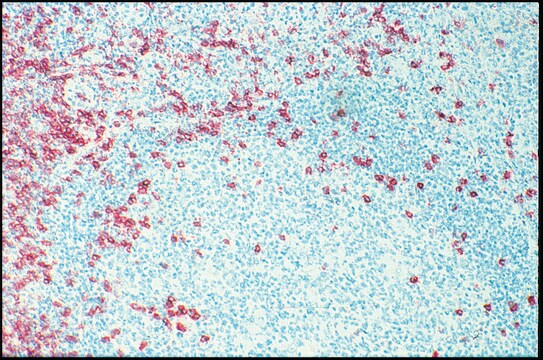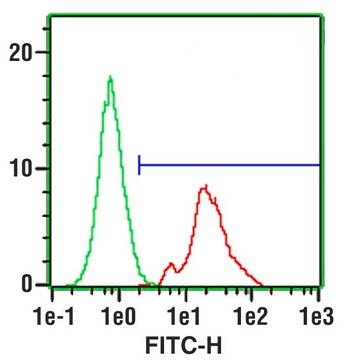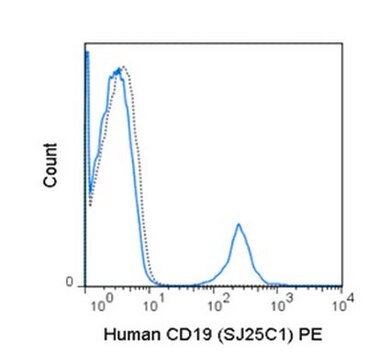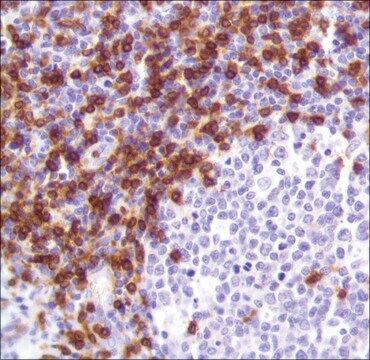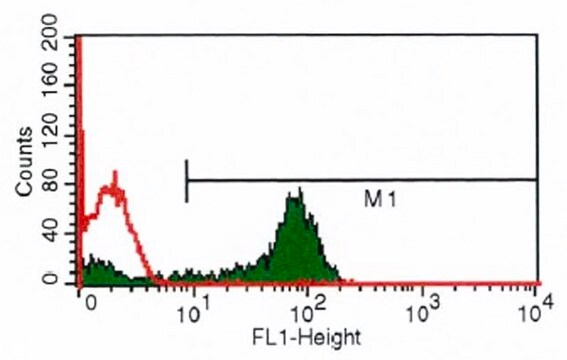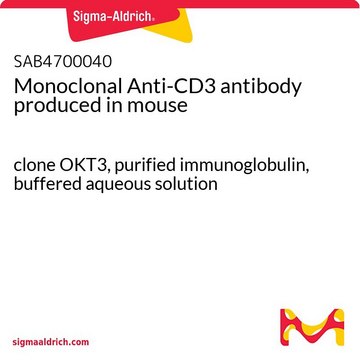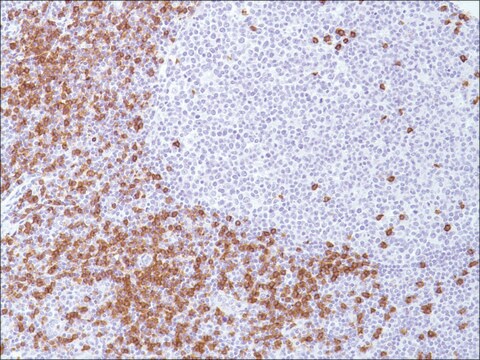SAB4700087
Monoclonal Anti-CD8-FITC antibody produced in mouse
clone MEM-31, purified immunoglobulin, buffered aqueous solution
Sign Into View Organizational & Contract Pricing
All Photos(1)
About This Item
UNSPSC Code:
12352203
NACRES:
NA.44
clone:
MEM-31, monoclonal
application:
FACS
species reactivity:
human
technique(s):
flow cytometry: suitable
citations:
9
Recommended Products
biological source
mouse
Quality Level
conjugate
FITC conjugate
antibody form
purified immunoglobulin
antibody product type
primary antibodies
clone
MEM-31, monoclonal
form
buffered aqueous solution
species reactivity
human
technique(s)
flow cytometry: suitable
isotype
IgG2a
NCBI accession no.
shipped in
wet ice
storage temp.
2-8°C
target post-translational modification
unmodified
Gene Information
human ... CD8(925)
Related Categories
General description
The antibody MEM-31 recognizes a conformationally-dependent epitope of CD8, a cell surface glycoprotein found on most cytotoxic T lymphocytes that mediates efficient cell-cell interactions within the immune system. CD8 is a disulfide-linked dimer and exists as a CD8 alpha/alpha homodimer or CD8 alpha/beta heterodimer (each monomer approx. 32-34 kDa).
Immunogen
Crude thymus membrane fraction
Application
The reagent is designed for Flow Cytometry analysis of human blood cells using 20 μL reagent / 100 μL of whole blood or 1e6 cells in a suspension. The content of a vial (2 mL) is sufficient for 100 tests.
Features and Benefits
Evaluate our antibodies with complete peace of mind. If the antibody does not perform in your application, we will issue a full credit or replacement antibody. Learn more.
Physical form
Solution in phosphate buffered saline containing 15 mM sodium azide and 0.2% high-grade protease free BSA as a stabilizing agent.
Disclaimer
Unless otherwise stated in our catalog or other company documentation accompanying the product(s), our products are intended for research use only and are not to be used for any other purpose, which includes but is not limited to, unauthorized commercial uses, in vitro diagnostic uses, ex vivo or in vivo therapeutic uses or any type of consumption or application to humans or animals.
Not finding the right product?
Try our Product Selector Tool.
Storage Class Code
10 - Combustible liquids
WGK
WGK 2
Flash Point(F)
Not applicable
Flash Point(C)
Not applicable
Choose from one of the most recent versions:
Already Own This Product?
Find documentation for the products that you have recently purchased in the Document Library.
Linda L Kusner et al.
PloS one, 9(7), e102231-e102231 (2014-07-23)
The mechanisms that underlie the development and maintenance of autoimmunity in myasthenia gravis are poorly understood. In this investigation, we evaluate the role of survivin, a member of the inhibitor of apoptosis protein family, in humans and in two animal
Wei Wu et al.
Critical care (London, England), 18(2), R43-R43 (2014-07-18)
Currently, little is known about the immunological characteristics of patients with avian influenza A (H7N9) virus infection. The numbers and percentages of peripheral blood immune cells were measured in 27 patients with laboratory-confirmed H7N9 virus infection and 30 healthy controls
Jing-Jing Zhao et al.
Chinese journal of cancer, 32(10), 553-560 (2013-03-09)
Chuankezhi (CKZ), a new Chinese medicine, plays an important role in immunoregulation. Cytokine-induced killer (CIK) cells have been commonly used for immunotherapy in recent years. In this study, we aimed to investigate the immunoregulatory effect of CKZ on CIK cells.
K Drbal et al.
Blood, 98(5), 1561-1566 (2001-08-25)
An unusual CD18 monoclonal antibody (mAb) MEM-148 binds, in contrast to standard CD18 mAbs, specifically to peripheral blood monocytes and neutrophils activated by various stimuli such as phorbol myristate acetate, opsonized zymosan, heat-aggregated immunoglobulin, and (after priming with lipopolysaccharide, tumor
Brian Latimer et al.
Human vaccines & immunotherapeutics, 10(8), 2357-2365 (2014-11-27)
Chronic HCV is a surreptitious disease currently affecting approximately 3% of the world's population that can lead to liver failure and cancer decades following initial infection. However, there are currently no vaccines available for the prevention of chronic HCV. From
Our team of scientists has experience in all areas of research including Life Science, Material Science, Chemical Synthesis, Chromatography, Analytical and many others.
Contact Technical Service
